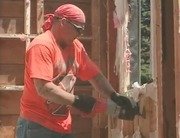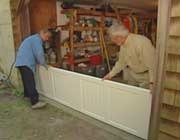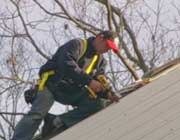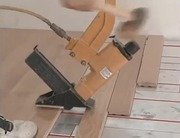our homeowner, Howard Brickman, has been, well you actually invented a bit of a testing device right?
To see how dry it really is?
Yeah, concrete's a real problem for the wood floor installation business, actually for any floor covering or coating in the business.
So we developed a meter that measures the relative humidity in the interior of the concrete, and it will predict what's going to happen after we cover it with the floor cover.
Exactly, and because of the nature of the whole shell of the house here, we are standing on a concrete slab.
The whole exterior structure except for the roof deck is concrete, and so it's critical that we dry the concrete on the floor prior to installing the wood floor on top.
Yeah, and that's the case anywhere in the country.
But especially in southern climates, where you have slabs on grade.
That's where you really have to check what you're doing.
Exactly, because you'll have ground moisture coming up.
Right.
So, while the house is drying out and all this interior work is going on, we can also be putting the siding on, right?
And because it's a concrete shell, Howard, how do you go about putting on the furring strips.
We attach the furring strips with an adhesive to the foam exterior structure.
And then you need these fasteners to make sure that the siding and everything is not going to go anywhere.
And Jack Armor is here from Powers, how do these things work?
Well, Bob, all you do is you simply drill a hole and drive down.
Right.
Same diameter as the diameter of the fastener.
OK.
So as far as this is concerned a quarter inch diameter, you drill a quarter inch hole into your substrate, right through your two by here.
Right into the masonry.
Exactly.
And does that, that wrinkle in the front end of it, that little band?
Yes, that's the s shape.
The s shape version of that.
What happens is it's bent and it's manufactured with the S-shape in there.
Yeah.
And then that turns into a heat treating process and once, once they heat treat that process, and they drive into the hole, it exerts against the walls of concrete, because it has memory and it wants to get back to that That's is how it works.
Exactly.
Now, this is a company that is almost a century old with this kind of a product, right?
That's correct, Powers Fasteners is formally known as the Ralpoint Company.
It was a European company in which they were the first manufacturers of a masonry anchor.
Which was marketed by the Powers family about 75 odd years ago in the United States.
Did they really make them out of jute?
Yeah, it was a jute fiber plug with a lead based insert.
Yeah, and then that evolved into the lead shield....
Which then came into the plastic.
Then came into the plastic, wonderful.
Well thanks for your help.
You're very welcome, Bob.
So Howard, this is what we're gonna be using for the siding.
What's it called?
It a HardiPlank, it's a fiber cement product.
So what does that mean, it , it's got Portland cement in it with some sort of fiber?
It's Portland cement with cellulose.
Wood fibers.
Which is wood fibers.
It's kind of counter-intuitive that the two would work well.
You would think so, but they do work extremely well together, this is a very, very durable product.
It takes paint extremely well.
But you're gonna use it with this finish already, right?
This is a pre-finished, so.
It goes installed with the color right on it.
Terrific.
The trim in New England houses houses has traditionally been made from pine, sometimes cedar.
We have a new product, it's called Asec.
Yes.
Right?
Asec Trembor .
And this is Christian Baer who's here to tell us all about it; what's it made out of?
Asec is, it's a cellular PVC product.
It's made by a manufacturing process called a free foam manufacturing process.
And what are the big advantages, I mean, it looks just like boards, it hasn't been painted up here, but it comes through like this right?
It is, yes, and this is going to give you the look and the feel of wood without any of the hassles.
For example it's impervious to moisture, termites, insects and it gives you a twenty five year warranty.
How is it to work with?
It's great to work with.
As you can see here, they routed this, as is, right on the house.
Oh you mean this, this edge that they've put on it?
Correct.
Was routed out after they'd applied the wood to the frame.
Yup.
Yeah, and it also provides moldings like we see up here, this crown?
Yes.
Currently AZEK has a crown mold, a drip cap, and a brick mold.
As of March 1st, there will be fifteen AZEK profiles available.
Amazing.
So, is AZEK very useful in different regions in terms of climate?
Yes.
Especially in New England, where there's harsh, harsh weather conditions.
Yeah.
And especially we're there's, on the water, AZEK holds up very nicely.
Right.
And in terms of cost, how does it compare?
You're looking about the same as a clear cedar, but once you repaint your wood, probably, every three to five years, you've already made your money back.
Yes, yes are there any warranties associated with it?
There's a 25 year warranty.
That's pretty impressive.
Yes it is.
Very good.
Well, the spring time weather comes back we'll have to put a coat of paint on it.
Absolutely, and you know with Phase II, you don't have to paint it for protection.
However, it holds paint very nicely.
Yeah, so you want to have your trim picked out in a different color obviously, you can do that.
Absolutely.
You want to use 100% acrylic latex paint and if you'd like to paint it a dark color, make sure you use VinylSafe made by Sherwin Williams.
Okay, we'll keep that in mind.
Thanks Kristen.
Next week we're gonna be working on the front porch; installing doors, putting up drywall, insulation and I can't think of what else.
Until then I'm Bob Vila.
Thanks for joining us.






